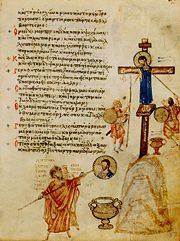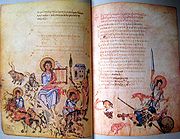
Chludov Psalter
Encyclopedia

Illuminated manuscript
An illuminated manuscript is a manuscript in which the text is supplemented by the addition of decoration, such as decorated initials, borders and miniature illustrations...
margin
Margin
Margin may refer to:*Margin *Margin , a type of financial collateral used to cover credit risk*Margin , the white space that surrounds the content of a page...
al Psalter
Psalter
A psalter is a volume containing the Book of Psalms, often with other devotional material bound in as well, such as a liturgical calendar and litany of the Saints. Until the later medieval emergence of the book of hours, psalters were the books most widely owned by wealthy lay persons and were...
made in the middle of the 9th Century. It is a unique monument of Byzantine art
Byzantine art
Byzantine art is the term commonly used to describe the artistic products of the Byzantine Empire from about the 5th century until the Fall of Constantinople in 1453....
at the time of the Iconoclasm
Iconoclasm
Iconoclasm is the deliberate destruction of religious icons and other symbols or monuments, usually with religious or political motives. It is a frequent component of major political or religious changes...
, one of only three illuminated Byzantine Psalters to survive from the 9th century.
According to one tradition, the miniatures are supposed to have been created clandestinely, and many of them are directed against Iconoclasts. Many contain explanations of the drawings written next to them, and little arrows point out from the main text to the illustration, to show which line the picture refers to. The polemical style of the whole ensemble is highly unusual, and a demonstration of the furious passions the Iconoclast dispute generated.
The psalter measures 195 mm by 150 mm and contains only 169 folios. The outer edges of the pages are normally left blank in order to be covered with illustrations. The text and captions were written in a diminutive uncial
Uncial
Uncial is a majuscule script commonly used from the 3rd to 8th centuries AD by Latin and Greek scribes. Uncial letters are written in either Greek, Latin, or Gothic.-Development:...
script
Handwriting
Handwriting is a person's particular & individual style of writing with pen or pencil, which contrasts with "Hand" which is an impersonal and formalised writing style in several historical varieties...
, but many of these were rewritten in crude minuscule about three centuries later. The book contains the Psalms in the arrangement of the Septuagint, and the responses to be chanted during their recitation, which follow the Liturgy of Hagia Sophia
Hagia Sophia
Hagia Sophia is a former Orthodox patriarchal basilica, later a mosque, and now a museum in Istanbul, Turkey...
, the Imperial church in Constantinople
Constantinople
Constantinople was the capital of the Roman, Eastern Roman, Byzantine, Latin, and Ottoman Empires. Throughout most of the Middle Ages, Constantinople was Europe's largest and wealthiest city.-Names:...
.

Patriarch of Constantinople
The Ecumenical Patriarch is the Archbishop of Constantinople – New Rome – ranking as primus inter pares in the Eastern Orthodox communion, which is seen by followers as the One, Holy, Catholic, and Apostolic Church....
, John the Grammarian
Patriarch John VII of Constantinople
John VII Grammatikos or Grammaticus, i.e., "the Grammarian" , Ecumenical Patriarch of Constantinople from January 21, 837 to March 4, 843, died before 867. He is not to be confused with the much earlier philosopher John Philoponos.-Life:John was born to an aristocratic family of Armenian origin...
rubbing out a painting of Christ with a similar sponge attached to a pole. John is caricatured, here as on other pages, with untidy straight hair sticking out in all directions, which was considered ridiculous by the elegant
Byzantine dress
Byzantine dress changed considerably over the thousand years of the Empire, but was essentially conservative. The Byzantines liked colour and pattern, and made and exported very richly patterned cloth, especially Byzantine silk, woven and embroidered for the upper classes, and resist-dyed and...
Byzantines.
Nikodim Kondakov
Nikodim Kondakov
Nikodim Pavlovich Kondakov , 1844, village of Khalan, Kursk Governorate, Russian Empire–February 17, 1925, Prague, Czechoslovakia), was a Russian historian, specialist in history of Byzantine art. Attended Moscow University under Fedor Buslaev in 1861–1865. Taught in the Moscow Art School...
hypothesized that the psalter was created in the famous monastery of St John the Studite in Constantinople
Constantinople
Constantinople was the capital of the Roman, Eastern Roman, Byzantine, Latin, and Ottoman Empires. Throughout most of the Middle Ages, Constantinople was Europe's largest and wealthiest city.-Names:...
. Other scholars believe that the liturgical responses it contains were only used in Hagia Sophia, and that it was therefore a product of the Imperial workshops in Constantinople, soon after the return of the Iconophiles to power in 843.
It was kept at Mount Athos
Mount Athos
Mount Athos is a mountain and peninsula in Macedonia, Greece. A World Heritage Site, it is home to 20 Eastern Orthodox monasteries and forms a self-governed monastic state within the sovereignty of the Hellenic Republic. Spiritually, Mount Athos comes under the direct jurisdiction of the...
until 1847, when a Russian scholar brought it to Moscow
Moscow
Moscow is the capital, the most populous city, and the most populous federal subject of Russia. The city is a major political, economic, cultural, scientific, religious, financial, educational, and transportation centre of Russia and the continent...
. The psalter was then acquired by Aleksey Khludov
Aleksey Khludov
Aleksey Ivanovich Khludov was a Russian Old Believer merchant who amassed the richest private collection of early mediaeval manuscripts in Imperial Russia....
, whose name it bears today. It passed as part of the Khludov bequest to the Nikolsky Old Believer Monastery and then to the State Historical Museum
State Historical Museum
The State Historical Museum of Russia is a museum of Russian history wedged between Red Square and Manege Square in Moscow. Its exhibitions range from relics of the prehistoric tribes inhabiting present-day Russia, through priceless artworks acquired by members of the Romanov dynasty...
.

